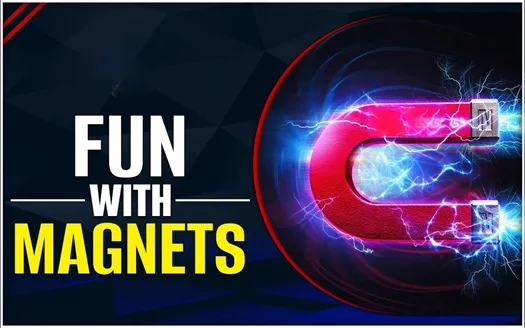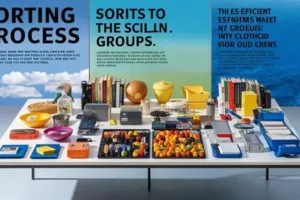
Class 6 Science Chapter 10 – Fun with Magnets
Fun with Magnets
NCERT Solutions for Class 6 Science Chapter 13 –

Fun with Magnets :
What is Magnet?
Fun with Magnets, Objects which attract magnetic materials like cobalt, nickel and iron are called a magnet.
The ancient, elderly Greek shepherd was the first person to discover minerals. It is a naturally occurring mineral called magnetite. Therefore, this naturally occurring mineral – magnet was named by the discoverer’s name. The magnets obtained naturally from a Magnetite rock are called natural magnets, and those magnets prepared by the combination of certain mineral ores are called as artificial magnets.
Magnetic Materials: Cobalt, nickel, and iron are some examples of Magnetic Materials. These materials easily attract a magnet.
Non-magnetic Materials: Aluminium, zinc, wood, and rubber are called Non-magnetic Materials, as these materials are not attracted towards the magnet even when they are brought closer to the magnet.
Types of Magnets
There are different types of magnets, and they are classified based on their shapes. The different types of magnets include – bar magnets, dumbbell-shaped magnets, horseshoe magnets, cylindrical magnets, etc.
Magnetic Compass
The magnetic compass is a simple device which has been used since ancient times by sailors and other travellers to find directions. A magnetic compass is composed of a small box with a glass top and a magnetic needle, which moves and indicates the directions.
Introduction Magnet and Magnetite: Fun with Magnets
- Substances that attract materials like iron, nickel etc.
- Magnets occur naturally as a particular type of rock.
- This rock is called magnetite.
Discovery of Magnets
Greeks used the term magnet in six hundred B.C. for the mysterious stone that seemed to attract iron and other materials. It was first discovered by a Greek shepherd named Magnes (hence the terminology) when his stick, which had an iron end got stuck to a rock.
To know more about Discovery of Magnets, visit the link below;
Discovery of Magnets
Magnetic and Non-magnetic Materials: Fun with Magnets
- Materials that get attracted towards a magnet are called magnetic materials. E.g. iron, cobalt or nickel.
- Materials that do not get attracted by a magnet are nonmagnetic materials. E.g. wood, plastic etc.
Poles of a Magnet
Every magnet is bipolar, i.e. they have 2 poles at the extremities. This can be seen by spreading iron filings around a magnet. These filings arrange themselves in a pattern which is mostly dense towards the two ends of a magnet. These poles are called North and South poles of a magnet.
How to Find Your Way Using a Magnet
Magnetic Poles of the Earth
- Earth has 2 geographic poles, the north and south poles.
- They are the Arctic (South Pole of the earth’s magnet) and Antarctica (North Pole of the earth’s magnet).
- Earth’s magnetic poles are near but not exactly in the same place as the geographic poles.
- A magnetic compass aligns itself towards the magnetic north pole of the earth.
Using Magnets to Find Directions: Fun with Magnets
- When a bar magnet is suspended freely by a thread, it aligns itself to the direction of North.
- Travellers have used this property of magnets for ages to find directions.
- A compass is a device with a magnetised needle pivoted inside a box covered by glass, which points to the direction of north and is a useful tool for finding directions.
Can You Make Your Own Magnet?
Making a Magnet
- The magnetic material can be made into a magnet by rubbing a magnet on the surface of the magnetic material.
- This creates an influence where the particles inside the material align themselves like the poles of a magnet.
Microscopic Cause of Magnetism
- Each particle in a magnetic material behaves somewhat like a bar magnet.
- They are normally aligned randomly within the material.
- But under the influence of a stronger magnet, they realign themselves according to the stronger magnet’s field.
Loss of Magnetic Property
The magnetic property of a magnet is lost on:
- Heating
- Hammering or hitting
- Dropping
Do Opposites Really Attract?
Attraction and Repulsion between Magnets:Fun with Magnets+
Like poles repel each other, while unlike poles attract each other.
Inseparable Poles
- Magnetic poles always exist in pairs.
- If you cut a bar magnet in half, it forms 4 poles, each half having a north and a south pole.
NCERT Solutions Q/A of Fun with Magnets
Q1 : What concepts can I learn from the NCERT Solutions for Class 6 Science Chapter 9?
From the NCERT Solutions for Class 6 Science Chapter 9, you can learn the concepts listed below:
Organisms and the surroundings where they live
Habitat and adaptation
A journey through different habitats
Some aquatic habitats
Characteristics of organisms
Living organisms and excretion
Q2 : List the common characteristics of the living things covered in Chapter 9 of NCERT Solutions for Class 6 Science.
Common characteristics of living things are as follows:
- i) Respiration
- ii) Food intake
iii) Respond to stimuli
- iv) Excretion
- v) Movement
- vi) Reproduction
vii) Grow and die
Q3 : Are the NCERT Solutions for Class 6 Science Chapter 9 sufficient for exam preparation?
Students who are looking for the perfect study material while learning new concepts can make use of the NCERT Solutions for Class 6 Science Chapter 9 from Orchids The International School. The solutions are framed by highly experienced faculty having vast knowledge of the fundamental concepts. The main objective of providing chapter-wise solutions is to improve the logical thinking approach of students to answer complex questions efficiently. The PDF of solutions is available at Orchids The International School with a free download option, where the students can access them anywhere and at any time.
Question 1 :
Where are poles of a bar magnet located?
Answer :
On two ends of a bar magnet.
Question 2 :
Fill in the blanks in the following
(i) Artificial magnets are made in different shapes such as __________, __________ and ____________.
(ii) The materials which are attracted towards a magnet are called________.
(iii) Paper is not a ______ material.
(iv) In the olden days, sailors used to find direction by suspending a piece of ___________.
(v) A magnet always has __________ poles.
Answer :
(i) Artificial magnets are made in different shapes such as bar magnet, horse shoe and cylindrical.
(ii) The materials which are attracted towards a magnet are called magnetic.
(iii) Paper is not a magnetic material.
(iv) In the olden days, sailors used to find direction by suspending a piece of magnet.
(v) A magnet always has two poles.
Question 3 :
It was observed that a pencil sharpener gets attracted by both the poles of a magnet although its body is made of plastic. Name a material that might have been used to make some part of it.
Answer :
ron might have been used to make some part of it.
Question 4 :
Column I shows different positions in which one pole of a magnet is placed near that of the other. Column II indicates the resulting action between them for each situation. Fill in the blanks.
| Column – I | Column – II |
| N-N | _______ |
| N-___ | Attraction |
| S-N | _____ |
| ___-S | Repulsion |
Answer :
| Column – I | Column – II |
| N-N | Repulsion |
| N- S | Attraction |
| S-N | Attraction |
| S– S | Repulsion |
Question 5 :
Write any two properties of a magnet.
Answer :
Properties of a magnet are as follows
- It attracts objects made of Nickel, Cobalt and Iron.
- Like poles of two magnets repel each other and opposite poles attract each other.
Question 6 :
A bar magnet has no markings to indicate its poles. How would you find out near which end is its north pole is located?
Answer :
A bar magnet is hung in the air, and the end pointing to the north is the north pole of the magnet.
Question 7 :
You are given an iron strip. How will you make it into a magnet?
Answer :
Take a bar magnet and keep in contact with one of its poles with one edge of the bar of iron.
- Without lifting the bar magnet, move it along the length of the iron bar till you reach the other end.
- Lift the magnet and bring the pole (the same pole you started with) to the same point of the iron bar from which we began.
- Move the magnet again along the iron bar in the same direction as you did before.
- Repeat this process for about 30-40 times.
Question 8 :
How is a compass used to find directions?
Answer :
A compass always shows north and south directions; by keeping this as a reference, we can always find east and west directions also.
Question 9 :
A magnet was brought from different directions towards a toy boat that has been floating in water in a tub. The effect observed in each case is stated in Column I. Possible reasons for the observed effects are mentioned in Column II. Match the statements given in Column I with those in Column II.
| Column I | Column II |
| Boat gets attracted towards the magnet | Boat is fitted with a magnet with a north pole towards its head |
| Boat is not affected by the magnet | Boat is fitted with a magnet with a south pole towards its head |
| Boat moved towards the magnet when the north pole was brought near its head | Boat has a small magnet fixed along its length |
| Boat moves away from the magnet when the north pole is brought near its head | Boat is made up of magnetic material |
| Boat floats without changing its direction | Boat is made up of non-magnetic material |
Answer :
| Column I | Column II |
| Boat gets attracted towards the magnet | Boat is made up of magnetic material |
| Boat is not affected by the magnet | Boat is made up of non-magnetic material |
| Boat moved towards the magnet when the north pole was brought near its head | Boat is fitted with a magnet with the south pole towards its head |
| Boat moves away from the magnet when the north pole is brought near its head | Boat is fitted with a magnet with a north pole towards its head |
| Boat floats without changing its direction | Boat has a small magnet fixed along its length |
Question 10 :
State whether the following statements are true or false:
(i) A cylindrical magnet has only one pole.
(ii) Artificial magnets were discovered in Greece.
(iii) Similar poles of a magnet repel each other.
(iv) Maximum iron filings stick in the middle of a bar magnet when it is brought near them.
(v) Bar magnets always point towards the North-South direction.
(vi) A compass can be used to find East-West direction at any place.
(vii) Rubber is a magnetic material.
Answer :
- i) False
ii) False
iii) True
iv) False
v) True
vi) True
vii) False



